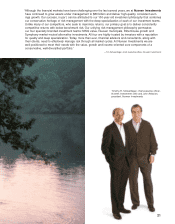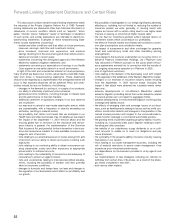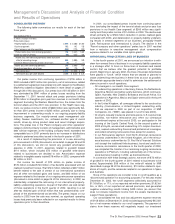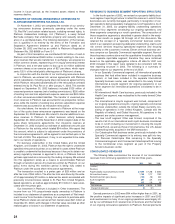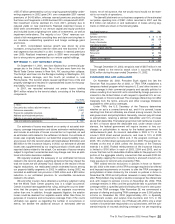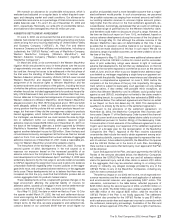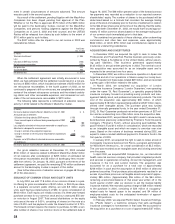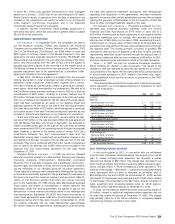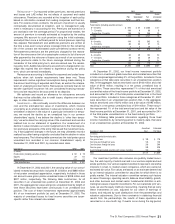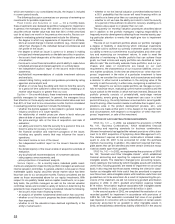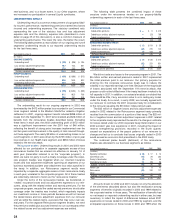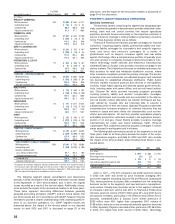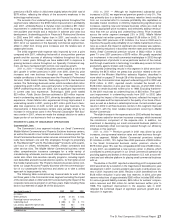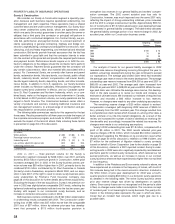Travelers 2002 Annual Report Download - page 32
Download and view the complete annual report
Please find page 32 of the 2002 Travelers annual report below. You can navigate through the pages in the report by either clicking on the pages listed below, or by using the keyword search tool below to find specific information within the annual report.
CERTAIN LITIGATION MATTERS
Settlement of Enron Corporation Surety Litigation — In December
2002, we announced that we, along with ten other insurance compa-
nies, had settled litigation with J.P. Morgan Chase Bank related to
surety contracts that had guaranteed certain obligations of Enron
Corporation to J.P. Morgan Chase under prepaid commodity forward
contracts. We agreed to pay $70 million and transfer our subrogation
rights against Enron. After estimated reinsurance recoverables of
$63 million, we recorded a pretax loss of $7 million related to the set-
tlement in the fourth quarter of 2002.
Petrobras Oil Rig Construction — In September 2002, the United
States District Court for the Southern District of New York entered a
judgment in the amount of approximately $370 million in favor of
Petrobras, an energy company that is majority-owned by the govern-
ment of Brazil, in a claim related to the construction of two oil rigs.One
of our subsidiaries provided a portion of the surety coverage for that
construction. As a result, we recorded a pretax loss of $34 million
($22 million after-tax) in 2002 in our Surety & Construction business
segment. The loss recorded was net of reinsurance and previously
established case reserves for this exposure, and prior to any possible
recoveries related to indemnity.We are actively pursuing an appeal of
this judgment.
Purported Class Action Shareholder Lawsuits — In the fourth
quarter of 2002, several purported class action lawsuits were filed
against us, our chief executive officer and our chief financial officer.
The lawsuits make various allegations relating to the adequacy of our
previous public disclosures and reserves relating to the Western
MacArthur asbestos litigation, and seek unspecified damages and
other relief.We view these lawsuits as without merit and intend to con-
test them vigorously.
Boson vs. Union Carbide Corp., et al. — Lawsuits have been filed
in Texas against one of our subsidiaries (United States Fidelity and
Guaranty Company), and other insurers and non-insurer corporate
defendants asserting liability for failing to warn of the dangers of
asbestos. It is difficult to predict the outcome or financial exposure rep-
resented by this type of litigation in light of the broad nature of the relief
requested and the novel theories asserted. We believe, however, that
the cases are without merit and we intend to contest them vigorously.
CRITICAL ACCOUNTING POLICIES
Overview — The St. Paul Companies, Inc. is a holding company
with subsidiaries operating in the property-liability insurance industry
and the asset management industry. We combine our financial state-
ments with those of our subsidiaries and present them on a consoli-
dated basis in accordance with United States generally accepted
accounting principles. Our significant accounting policies are set forth
in Note 1 to our consolidated financial statements. The following is a
summary of the critical accounting policies related to accounting esti-
mates that 1) require us to make assumptions about highly uncertain
matters and 2) could materially impact our consolidated financial
statements if we made different assumptions.
Loss Reserves — The most significant estimates relate to our
reserves for property-liability insurance losses and loss adjustment
expenses (“LAE”). We establish reserves for the estimated total
unpaid cost of losses and LAE, which cover events that have already
occurred. These reserves reflect our estimates of the total cost of
claims that were reported to us, but not yet paid (“case”reserves), and
the cost of claims “incurred but not yet reported” to us (“IBNR”
reserves). For reported losses, we establish case reserves within the
parameters of coverage provided in the insurance policy, surety bond
or reinsurance agreement. For IBNR losses, we estimate reserves
using established actuarial methods. We continually review our
reserves, using a variety of statistical and actuarial techniques to ana-
lyze current claim costs, frequency and severity data, and prevailing
economic, social and legal factors. We also take into consideration
other variables such as past loss experience, changes in legislative
conditions, changes in judicial interpretation of legal liability and pol-
icy coverages, changes in claims handling practices and inflation. We
30
consider not only monetary increases in the cost of what we insure,
but also changes in societal factors that influence jury verdicts and
case law, our approach to claim resolution, and, in turn, claim costs.
For certain catastrophic events, there is considerable uncertainty
underlying the assumptions and associated estimated reserves for
losses and LAE. Reserves are reviewed regularly and, as experience
develops and additional information becomes known, including
revised industry estimates of the magnitude of a catastrophe, the
reserves are adjusted as we deem necessary.
Because many of the coverages we offer involve claims that may
not ultimately be settled for many years after they are incurred, sub-
jective judgments as to our ultimate exposure to losses are an integral
and necessary component of our loss reserving process. We analyze
our reserves by considering a range of estimates bounded by a high
and low point, and record our best estimate within that range. We
adjust reserves established in prior years as loss experience develops
and new information becomes available. Adjustments to previously
estimated reserves, both positive and negative, are reflected in our
financial results in the periods in which they are made, and are
referred to as prior period development. Because of the high level of
uncertainty involved in these estimates, revisions to our estimated
reserves could have a material impact on our results of operations in
the period recognized, and ultimate actual payments for claims and
LAE could turn out to be significantly different from our estimates.
Reserves for environmental and asbestos exposures cannot be
estimated solely with the traditional loss reserving techniques
described above, which rely on historical accident year development
factors and take into consideration the previously mentioned vari-
ables. Environmental and asbestos reserves are more difficult to esti-
mate than our other loss reserves because of legal issues, societal
factors and difficulty in determining the parties who may ultimately be
held liable.Therefore, in addition to taking into consideration the tradi-
tional variables that are utilized to arrive at our other loss reserve
amounts, we also look at the length of time necessary to clean up pol-
luted sites, controversies surrounding the identity of the responsible
party, the degree of remediation deemed to be necessary, the esti-
mated time period for litigation expenses, judicial expansions of cov-
erage, medical complications arising with asbestos claimants’
advanced age, case law, and the history of prior claim development.
We also consider the impact of changes in the legal environment,
including our experience in the Western MacArthur matter, in estab-
lishing our reserves for other asbestos and environmental cases.
Generally, case reserves and loss adjustment expense reserves are
established where sufficient information has been obtained to indicate
coverage under a specific insurance policy. We also consider end of
period reserves in relation to paid losses in a period. Furthermore,
IBNR reserves are established to cover additional estimated expo-
sures on both known and unasserted claims.These reserves are con-
tinually reviewed and updated as additional information is acquired.
During 2002, we concluded that the impact of settling claims in a
runoff environment in our Health Care segment was causing abnor-
mal effects on our average paid claims, average outstanding
claims, and the amount of average case reserves established for new
claims — all of which are traditional statistics used by our actuaries to
develop indicated ranges of expected loss.Taking these changing sta-
tistics into account, we developed varying interpretations of our data,
which implied added uncertainty in our evaluation of these reserves.
In the fourth quarter of 2002, we established specific tools and
indicators to more explicitly monitor and validate our key assumptions
supporting our Health Care reserve conclusions since our traditional
statistics and reserving methods needed to be supplemented in order
to provide a more meaningful analysis. The tools we developed will
track the three primary indicators which are influencing our expecta-
tions and include: a) newly reported claims, b) reserve development
on known claims and c) the “redundancy ratio,” comparing the cost of
resolving claims to the reserve established for that individual claim. It
is our belief that this data, when appropriately evaluated in light of the
impact of our migration to a runoff environment, supports our view
that we will realize significant savings on our ultimate claim costs.



